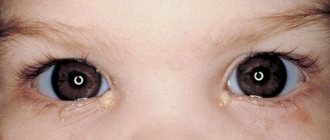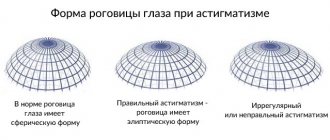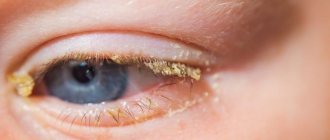What is inflammation of the conjunctiva?
Conjunctivitis is an inflammatory process on the mucous membrane of the eyes. It can begin under the influence of various factors:
- when viruses penetrate;
- as a result of an allergic reaction;
- due to trauma;
- upon penetration of bacteria.
Due to the latter type of pathogens getting into the eyes, bacterial conjunctivitis develops in the child. As a result, the patient feels discomfort in the eyes. The disease must be treated necessarily, because it can lead to complications.
Etiology
The immediate cause of the disease is the contact of a pathogenic bacterium on the conjunctiva. Infection can occur in a maternity hospital, kindergarten, school, or any children's group.
Is bacterial conjunctivitis contagious? It is transmitted from person to person. Therefore, a sick child should be isolated from society until complete recovery.
Predisposing factors to the development of pathology are:
- weakened immunity;
- failure to comply with hygiene measures (bacteria are transmitted through household contact);
- for newborns - a violation of the vaginal microflora in the mother, the presence of diseases such as chlamydia, gonococcus, candidiasis. Infection occurs when passing through the birth canal;
- mechanical eye injuries;
- sinusitis, tonsillitis and other infectious diseases. It is possible that the infectious agent may be transferred to the conjunctival area;
- insufficient air humidity in the room: the mucous membrane dries out and becomes more vulnerable to bacteria.
Children aged two to three years are most susceptible to bacterial conjunctivitis. The child’s immunity is not fully formed and cannot reliably protect the body from infection. In addition, at this age it is difficult for parents to ensure that their children do not rub their eyes with dirty hands.
Causes of the disease
The inflammatory process occurs as a result of penetration of bacteria into the mucous membrane. This can happen when a child touches his face with dirty hands or uses personal belongings of an infected person (towel, soap, bed linen, etc.).
A person does not necessarily become ill immediately when the pathogen enters the body. To begin their active reproduction, the influence of predisposing factors is necessary:
- suffered a serious illness;
- presence of chronic diseases;
- other forms of conjunctivitis (viral, allergic);
- hypothermia;
- poor nutrition;
- rare walks in the fresh air;
- frequent stressful situations.
Rice. 1. In other words, bacteria can provoke an inflammatory process only if the child has a weakened immune system.
Pathogens also cause conjunctivitis in the baby if the mother suffered from staphylococci, streptococci, etc. during pregnancy. They penetrate the mucous membrane during labor, i.e. when the baby is born. Therefore, before giving birth, a woman must be cured of various infections.
Expert opinion
Ermolaeva Tatyana Borisovna
Ophthalmologist of the highest category, Candidate of Medical Sciences
Note! Often, conjunctivitis can be epidemiological in nature. Especially in kindergarten. If one person in a group gets sick, then half the team is likely to become infected. This is due to the fact that in the garden children play with common toys and touch each other.
Difference between bacterial and viral conjunctivitis
Although these two diseases affect the conjunctiva of the eye, they are different. First of all, this is due to pathogenic microflora that causes conjunctivitis.
There is also a difference in the main symptoms in the clinical picture of these diseases. Drug therapy requires a different approach to treating the disease.
The etiology of viral conjunctivitis is infection with a viral infection. Most often this happens when infected with the herpes virus.
Bacterial conjunctivitis is not contagious, unlike viral conjunctivitis.
Due to previous colds:
- Flu.
- ARVI.
- Angina.
- Otitis of the middle or external ear.
Symptoms in children
The symptoms of a bacterial inflammatory process are difficult to confuse with any other diseases:
- purulent discharge that sticks the eyelashes together and prevents the eyelids from opening wide (this is especially noticeable after sleep);
- swelling, with severe damage the eyeball is barely noticeable;
- redness of the mucous membrane, sometimes there are bruises on it, which resolve on their own after a while;
- fear of bright light;
- severe tearing (at the initial stage of the inflammatory process).
Expert opinion
Ermolaeva Tatyana Borisovna
Ophthalmologist of the highest category, Candidate of Medical Sciences
Note! The last symptom after a few days is replaced by dry eyes. Because of this, damage and microcracks appear on the conjunctiva, which cause severe pain.
Rice. 2. If a child's eyelid is swollen, the cause most likely lies in conjunctivitis. However, it may also indicate an eye injury.
Clinical manifestations
Characteristic signs of the bacterial form of conjunctivitis include:
- mild eye hyperemia;
- discomfort, burning and itching;
- strong purulent discharge;
- sticking of the eyelids due to the hardening of purulent secretion and its settling on the eyelashes;
- edema;
- formation of yellowish crusts on the eyes.
The incubation period of the pathology ranges from several hours to several days. Usually the first signs appear on the first or second day after infection. The child's eyelids swell and the mucous membrane turns red. The baby feels irritation and burning, as if there is a foreign object in the eyes.
On the third day, painful sensations arise. The mucous membrane becomes inflamed, tear fluid begins to be intensively produced.
The next two days are accompanied by strong purulent discharge. The capillaries become red and may rupture, which is manifested by pinpoint hemorrhages. The child has difficulty opening his eyes; accumulations of pus are observed on the eyelashes and in the corners of the eyes.
On the sixth day, fever appears, accompanied by general weakness and headache. The child is restless and does not sleep well. Older children complain of blurred vision.
Possible complications
Adverse consequences of conjunctivitis include:
- severe swelling, due to which the eyes are completely invisible;
- spread of infection to neighboring tissues, which causes otitis media, sinusitis, and tonsillitis;
- penetration of pathogens into the internal tissues of the eyeball, which provokes clouding and blurred vision;
- contact of pathogens with muscle tissue, which causes strabismus;
- penetration of bacteria into the circulatory system, resulting in the development of sepsis, which poses a threat to life (this happens extremely rarely);
- development of keratitis;
- blepharitis.
Expert opinion
Ermolaeva Tatyana Borisovna
Ophthalmologist of the highest category, Candidate of Medical Sciences
Note! Complications of conjunctivitis include the transition of the inflammatory process to a chronic form. That is, even after the disease can be cured, it will periodically appear again at the slightest weakening of the immune system.
Rice. 3. Blepharitis in a child is one of the complications of conjunctivitis.
Does bacterial conjunctivitis affect a child's vision?
During the inflammatory process, the child’s vision may deteriorate due to severe irritation and purulent discharge. However, after treatment it is usually restored.
If conjunctivitis leads to complications, they, in turn, can worsen vision or even deprive it forever. That is why doctors recommend that when the first signs of an inflammatory process occur, immediately contact a medical institution for help, and not try to get rid of the infection on your own.
Read about the features of adenoviral conjunctivitis in our article.
Diagnostics
From a medical point of view, the most striking symptom is the redness of the whites. Therefore, diagnosis includes examination of the conjunctiva using a directed beam of light. Thanks to him, the doctor sees the inner area of the eye, which will be covered with a network of hemorrhages. Along with the flow of pus and the release of tear fluid, this clearly indicates the presence of the disease.
To make an accurate diagnosis, a laboratory smear test is required. Accordingly, the doctor takes a sample from the white of the patient’s eye. The specified sample is studied to find out which microorganisms caused the disease.
That is, diagnostics includes instrumental and laboratory methods.
How to treat
Typically, bacterial conjunctivitis is treated on an outpatient basis.
Hospitalization may be necessary if there is a risk of complications. Any medications must be prescribed by a doctor.
Disinfectants and cleaning agents
Since bacterial conjunctivitis causes pus to form in the eyes, it must first be removed. You cannot use drops or ointments right away, because... when using drugs, secretions containing pathogens will fall back onto the mucous membrane. As a result, the procedures will be ineffective.
For disinfection and cleansing, you can use furatsilin or saline solution. The first remedy not only removes pus, but also suppresses the proliferation of pathogenic microflora. Saline solution does not destroy germs, it only clears secretions.
You need to moisten 2 cotton pads in these solutions (one for each eye) and wipe from the inner corner to the outer, after washing your hands with soap. Such procedures should be done not only before using drops and ointments, but throughout the day, every 2-3 hours.
Eye drops
The following antibacterial drugs in the form of eye drops are intended for children:
- Fucithalmic. Allowed even for newborns. Usually the medicine is prescribed in a course of a week, 1 drop in each eye twice a day.
- Albucid. Can also be used from birth. 1-2 drops are instilled 5 times a day for 7 days.
- Vitabact. 1 drop is administered 2-6 times a day. Can be used for up to 10 days in a row. Allowed from birth.
- Levomycetin. Prescribed to children from 2 years of age. One drop is instilled every 2 hours. It is recommended to use it for prevention after recovery for another week. In this case, the drug is used every 4 hours.
- Oftalmoferon. Can be used on newborns. The drug not only stops the inflammatory process, but also has an analgesic effect, because Contains diphenhydramine.
- Chloramphenicol. It should be used every 2 hours at first, and as the symptoms subside, reduce the number of applications.
Expert opinion
Ermolaeva Tatyana Borisovna
Ophthalmologist of the highest category, Candidate of Medical Sciences
Note! The most common schemes for using drops are listed above. In some cases, your doctor may decide on a different dosage.
How to give drops to a baby
Step by step steps:
- Wash your hands with antibacterial soap and dry with a sterile towel.
- Place the child on his back on the table, placing a cushion under his neck to secure the position.
- Take a separate cotton pad for each eye and dip it in any rinsing solution mentioned earlier.
- Gently wipe from the inner corner to the outer to remove any pus that has formed.
- Carefully pull back the lower eyelid and apply the required number of drops to each eye with a dispenser or pipette so that they fall on the conjunctiva.
Rice. 4. In order not to accidentally harm the child, before burying you need to remove all jewelry from your hands and cut your nails.
Expert opinion
Ermolaeva Tatyana Borisovna
Ophthalmologist of the highest category, Candidate of Medical Sciences
Note! During the procedure, it is impossible for the drug to come into contact with the cornea, because It may be dangerous. It is also undesirable to put drops into the conjunctival sac, because this will cause severe tearing. As a result, the medicine will be washed off without having time to work.
How to put drops in the eyes of a child from 1 to 5 years old
It is more difficult to treat bacterial conjunctivitis in children over 1 year of age with drops, because they will resist. You can see how to properly instill the drug into their eyes in the video clip of Dr. Komarovsky:
Ointments
Eye drops are prescribed for use during the day, but ointments must be applied at night:
- erythromycin;
- tetracycline
Ointments can be placed under the lower eyelid before the child goes to bed or smeared on top of the corners of the eyelids. how to treat with drugs of this form.
Local antibiotics
Local antibiotics include the previously mentioned drops and ointments.
They destroy pathogens and eliminate unpleasant symptoms.
Oral antibiotics
Oral use of antibacterial drugs is prescribed only in advanced cases with the development of complications. For example, penetration of pathogens into the nasopharynx, ears, etc.
After administration, the medicine enters the blood and travels with it throughout the body. Children can be prescribed Amoxiclav, Suprax, Zinnat, etc.
Folk recipes
The following folk remedies help relieve the symptoms of conjunctivitis:
- Chamomile infusion. 1 tsp. dry herb, which is sold in a pharmacy, pour a glass of boiling water. Wait until it cools down with the lid closed, strain and use for rinsing.
- Black tea. Do not use too strong tea leaves. The bag can be kept in boiling water for no more than a minute, then taken out and allowed to cool to room temperature. Wash with tea.
- Echinacea decoction. Grind the roots of the plant, 1 tbsp. l. pour a glass of boiling water over the raw materials. Keep in a water bath for 10-15 minutes. Cool and strain. You can take it orally (give the child 2 tablespoons 4 times a day) or use the infusion for lotions.
Expert opinion
Ermolaeva Tatyana Borisovna
Ophthalmologist of the highest category, Candidate of Medical Sciences
Important! Before using any folk remedy, you need to consult a doctor. Despite the fact that they consist only of natural ingredients, they can aggravate the patient’s condition by provoking an allergic reaction.
Treatment with folk remedies
The use of folk recipes to treat the disease in children is not recommended, especially when it comes to infants - improper therapy will worsen the patient’s condition and cause serious complications. Remedies that can be used without fear include herbal infusions (chamomile, string, calendula), as well as black and green tea. They have an anti-inflammatory and calming effect, so they are recommended for washing the eyes and removing pus.
During treatment, it is necessary to filter the liquid well so that small particles do not get into the child’s eye, and also monitor the temperature and concentration of the infusions - a tablespoon of crushed herbs or a tea bag per glass of water.
It is strictly not recommended to put aloe juice, solutions containing honey, essential oils and other viscous liquids into a child’s eyes - they aggravate the course of the disease, create a favorable environment for the growth of bacteria and interfere with normal access of oxygen.
Prevention
Prevention of bacterial conjunctivitis includes:
- use of personal care products (soap, towel, etc.);
- timely treatment of concomitant colds and eye diseases;
- frequent hand washing;
- daily wet cleaning and airing of rooms;
- strengthening the immune system (walking, balanced nutrition, sports, hardening, taking vitamin and mineral complexes);
- routine visit to the ophthalmologist;
- swimming in a public pool and natural pond wearing special swimming goggles.
From all of the above, it becomes clear that it is very easy to become infected with bacterial conjunctivitis, especially for a child. Fortunately, with timely treatment, the inflammatory process will not affect your health in any way. However, parents should understand that without therapy prescribed by a doctor, the risk of serious complications increases, which can even lead to blindness. Therefore, visiting a clinic or calling a doctor at home for bacterial conjunctivitis is mandatory.











